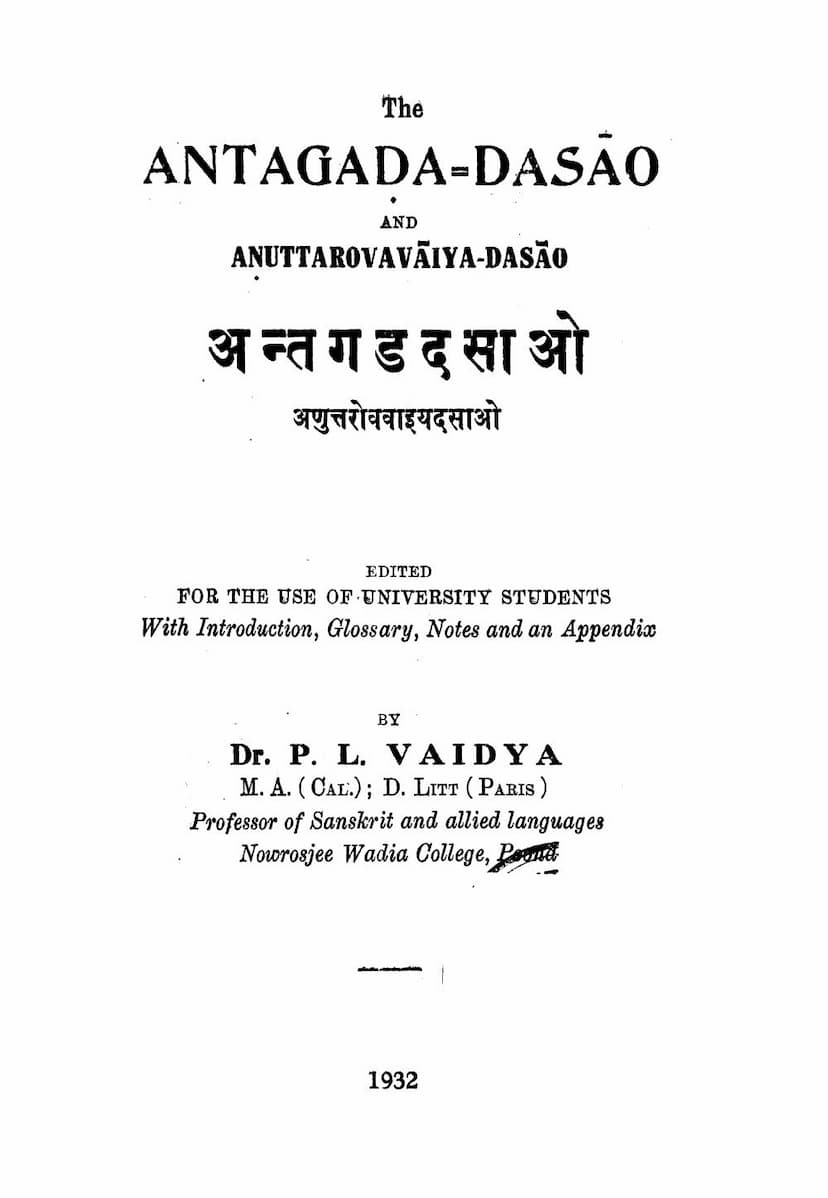Antgadadasao Evam Anuttaravavaidasao
Added to library: September 1, 2025

Summary
This comprehensive summary details the Jain texts "Antagadadasao" (अन्तगडदसाओ) and "Anuttarovavaiyadasao" (अणुत्तरोववाइयदसाओ), as presented in Dr. P. L. Vaidya's 1932 edition.
Book Overview and Context:
- Title: Antagadadasao evam Anuttarovavaiyadasao (The AND ANTAGADA-DASAO ANUTTAROVAVAIYA-DASAO)
- Author: Dr. P. L. Vaidya (M. A., D. Litt.)
- Publisher: P. L. Vaidya
- Year: 1932
- Purpose: Edited for university students, specifically Intermediate Arts Students of the Bombay University.
- Previous Editions: Mention is made of editions from Calcutta (1875) and Surat (1922), as well as Dr. L. D. Barnett's translation (1907).
- Content: The volume includes the texts of both Antagadadasao and Anuttarovavaiyadasao, along with an introduction, glossary, notes, and an appendix.
- Glossary: Provides Prakrit words with their Sanskrit and English meanings.
- Appendix: Contains an extract from the Bhagavati Sutra on the story of Skandaka, due to frequent references in the texts.
- Notes: Aim to help students master the texts, with reduced commentary due to prior study of similar texts like Uvasagadasao.
- Manuscripts: The condition of manuscripts is noted as indifferent, indicating these texts may have been less frequently studied by the Jain community.
Summary of Antagadadasao (The eighth Anga of the Jain Canon):
- Structure: Divided into eight vaggas (chapters) and ninety-two ajjhayanas (lessons).
- Theme: Each lesson describes a person (man or woman) who attained antakṛt (a happy end, perfection) in their worldly life.
- Chronological Division:
- The first five vaggas narrate the lives of individuals who lived during the time of the 22nd Tirthankara, Aritthanemi.
- The last three vaggas focus on individuals from the era of Mahavira.
- It is suggested the work might have originally been two separate texts.
- Key Narratives:
- Vaggas 1 & 2: Detail ten princes each, all sons of Andhagavanhi and Dharini, who renounced the world and attained perfection under Aritthanemi.
- Vagga 3 (Gayasukumara):
- Features the interesting story of Naga and Sulasa, whose children were miraculously substituted with Devaki's six sons by the deity Harinaigamesin.
- These six adopted brothers, appearing identical, became monks.
- The narrative recounts their begging tour and Devaki's confusion and eventual understanding of the divine intervention.
- Devaki's sadness at not enjoying her own children leads Krishna to seek a boon for her to have an eighth son, Gayasukumara.
- Gayasukumara, after experiencing worldly life and the discourse of Aritthanemi, becomes a monk.
- He attains perfection despite enduring severe torture from Somila, who sought revenge for the abandonment of his daughter Soma.
- Vagga 4: Similar narratives to the third chapter.
- Vagga 5: Ten narratives of ladies, eight of whom were wives of Krishna, and the last two were wives of Samba. These women renounce the world following Krishna's warning about the impending ruin of Dwarka.
- Vagga 6:
- Arjunaka and Bandhumati: A gardener devoted to the Yaksha Mudgarapani is abducted with his wife. Mudgarapani, entering the gardener's body, causes chaos. The story culminates with the gardener becoming a monk after being enlightened by Mahavira and patiently enduring insults.
- Atimukta: A prince who joins the Order of monks after listening to Mahavira's discourse, understanding dharma through the realization of impermanence and the law of karma.
- Vaggas 7 & 8: Twenty-three wives of King Seniya join the nun's order, practice penances under Candana (Mahavira's chief nun), and attain perfection.
Summary of Anuttarovavaiyadasao (The ninth Anga of the Jain Canon):
- Title Meaning: Literally translates to "ten (lessons in the first chapter) on persons born in the five Anuttara-mansions" (highest heavenly mansions).
- Structure: Contains three chapters and thirty-three lessons, described as mostly mechanically narrated.
- Key Feature: The work is noted for its description of Dhanna's body becoming emaciated due to severe penance.
- Content: Focuses on individuals who were reborn in the five Anuttara heavens, signifying the highest heavenly abodes according to Jain cosmology.
Appendix: Skandaka Kathānaka (Story of Skandaka)
- Source: Extracted from the Bhagavati Sutra.
- Narrative:
- Mahavira is residing near Rajagriha.
- Skandaka Kacyayana, a disciple of the ascetic Pingala, is approached by Pingala with philosophical questions about the nature of the universe, soul, and liberation. Skandaka, unable to answer, remains silent.
- Later, Skandaka, overwhelmed by public opinion and his own inability to answer Pingala's questions, decides to approach Mahavira.
- He abandons his ascetic possessions and proceeds to Mahavira's presence.
- Mahavira, aware of Skandaka's past and future, addresses him.
- The text provides a detailed discourse from Mahavira on the nature of the world (substance, space, time, mode), the soul, and liberation, emphasizing the subtle philosophical distinctions.
- Mahavira also clarifies the nature of death, differentiating between childlike deaths (unwise, leading to repeated births) and wise deaths (resulting from penance and leading to better rebirths or liberation).
- Skandaka, enlightened by Mahavira's teachings, accepts the Jain path, renounces his former beliefs, and eventually attains perfection after rigorous penance, including observing various vows like the Masika Bhikshupratima (a vow of accepting only one meal and drink per month) and culminating in the Gunaratna Samvatsara Tapokarma (a year-long penance).
- The narrative highlights Skandaka's profound austerities and his ultimate liberation.
Overall Significance:
This edition by Dr. P. L. Vaidya aims to make these important Jain scriptures accessible to students, providing crucial context, explanations, and a glossary to aid in understanding the complex philosophical and narrative content. The texts themselves offer insights into the lives of exemplary individuals in Jainism who achieved liberation, providing moral and spiritual guidance. The inclusion of the Skandaka story in the appendix further illuminates the philosophical depth and the importance of rigorous practice in the Jain tradition.